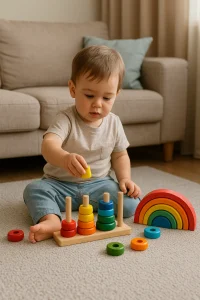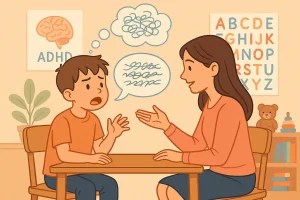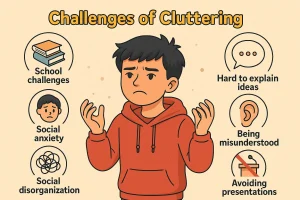8 Fun Activities to Slow Down Speech and Improve Clarity
Last Updated: April 22, 2025
Does your child speak too fast, mumble, or struggle to get their words out clearly? You’re not alone—and the good news is, there are simple ways to help. For many children (and even adults), speaking too quickly can lead to jumbled words, unclear pronunciation, or frustration when others can’t understand them. Whether it’s due to speech delay, nervousness, or just an eager little brain moving faster than the mouth, learning how to slow down speech and improve clarity can make a big difference. And guess what? It doesn’t have to be boring! With the right kind of playful, everyday activities, your child can learn to speak more clearly—and have fun while doing it.
Why Is It Important to Slow Down Speech and Improve Clarity?
Speaking clearly isn’t just about sounding good—it’s about being understood. When speech is too fast or jumbled, it becomes hard for listeners to keep up, especially if a child is still learning how to express themselves. Slowing down the way we talk gives the brain and mouth time to sync up, making communication smoother and more effective.
Here’s how speech rate control and speech clarity benefit everyday conversations:
| Benefit | Why It Matters |
|---|---|
| Better Understanding | Clear, paced speech helps others follow along easily—no more “What did you say?” |
| Boosts Confidence | Children (and adults) feel more confident when they’re understood the first time. |
| Improves Learning | When kids speak clearly, they’re more likely to be understood at school and during play. |
| Reduces Frustration | Less need to repeat themselves means fewer tantrums or shutdowns. |
Who Needs These Activities?
You might be wondering—“Is this something my child really needs?” If you’ve noticed your child rushing through words, stumbling mid-sentence, or being hard to understand, these fun, hands-on activities can help.
These techniques are especially useful for:
- Children with speech delays
They may need extra time to form sounds and structure sentences. Slowing down supports their speech development. - People who speak too fast
Whether it’s due to excitement, anxiety, or habit, fast speech often leads to missed words and unclear pronunciation. - Anyone looking to improve speech fluency
From toddlers to teens (and even adults), learning to pace your speech is a powerful tool for better communication.
8 Fun Activities to Slow Down Speech and Improve Clarity
You don’t need fancy tools or long therapy sessions to support your child’s speech clarity. These fun, everyday activities turn practice into play—helping your child slow down their speech and speak more clearly without the pressure.
1. Read Aloud with Emphasis
Reading aloud is one of the easiest and most effective speech clarity exercises. Pick a short story or favorite book, and ask your child to read it slowly—with clear pauses at commas and full stops.
Why it works:
- Builds awareness of pacing
- Improves pronunciation naturally
- Helps children recognize sentence structure
Pro Tip: Take turns reading! You model the pace first, then let your child try.
2. Role-Play Conversations
Pretend play isn’t just fun—it’s great for building communication skills. Try acting out everyday situations like ordering food, visiting a doctor, or calling a friend. Use clear sentences, expressions, and natural pauses.
Why it works:
- Encourages real-world communication
- Makes speech pacing feel natural
- Helps kids practice turn-taking in conversations
3. Use the “Turtle Talk” Technique
Ask your child to speak “like a turtle”—slow and steady. Exaggerating each word and stretching syllables makes it playful and helps them control their speech rate.
Why it works:
- Makes slow speech feel fun, not forced
- Great for younger children or beginners
- Reinforces self-monitoring
Add a toy turtle or visual cue to make it extra engaging.
4. Sing Songs with Slowed Lyrics
Singing helps children practice rhythm and pronunciation. Choose simple songs your child knows and slow down the tempo while singing together.
Why it works:
- Builds a sense of speech rhythm
- Encourages clearer enunciation
- Adds musical fun to speech practice
Bonus tip: Use action songs like “If You’re Happy and You Know It” for added movement and memory!
5. Record and Listen
Use a smartphone to record your child speaking a sentence quickly and then slowly. Play it back together to compare the difference.
Why it works:
- Raises awareness of speech rate control
- Builds self-confidence
- Helps track progress over time
Keep it light: laugh together at the fast versions and cheer for improvements in the slow ones!
6. Breathing and Pausing Games
Teach your child to take a deep breath before speaking and pause briefly between phrases. Turn it into a game—count 1-2 between thoughts, or blow bubbles to practice calm breathing.
Why it works:
- Supports oral motor control
- Reduces rushed speech
- Promotes calm and focus
Fun twist: Blow up a balloon while talking slowly. If the balloon stays still, they’re doing great!
7. Mirror Speaking Practice
Let your child speak in front of a mirror. This helps them notice how their mouth moves and what their face looks like when they speak clearly.
Why it works:
- Builds self-awareness
- Improves articulation and expression
- Encourages confident speaking
Tip: Make silly faces first to relax and make it fun!
8. Pacing Board or Finger Tapping
Use a simple pacing board (a strip with four to five dots or boxes) or ask your child to tap a finger for each word they say. This visual and tactile method reinforces slow, steady speech.
Why it works:
- Encourages speech pacing
- Builds rhythm and control
- Helps children who speak too fast slow down naturally
Even fingers can be a pacing tool—no materials needed!
Tips for Parents and Educators
Supporting a child’s speech doesn’t require perfection—it requires patience, consistency, and a little creativity. Whether you’re a parent, teacher, or caregiver, these small but meaningful shifts can make speech practice feel like a natural part of everyday life.
Here are a few key tips to help you along the way:
Be Patient and Encouraging
Progress may be slow at times, and that’s okay. Celebrate every small win—whether it’s a clearly spoken word or a successful pause between phrases.
Try this:
- Use positive phrases like “I love how clearly you said that!”
- Avoid correcting in a harsh tone—gently model the right way instead
Confidence grows when children feel safe and supported.
Make It Fun and Consistent
Kids learn best when they’re having fun. Turn home speech activities into games, challenges, or bonding moments.
Ideas to keep things engaging:
- Create a sticker chart to track speech practice days
- Use a favorite puppet or toy as a “talking buddy”
- Pick a “speech game of the day” from your routine
A little daily consistency—even just 10 minutes—goes a long way.
Blend Speech Activities into Daily Life
You don’t always need “extra time” to practice speech. Look for moments during meals, playtime, or even bath time to include speech development exercises naturally.
Simple ways to fit it in:
| Everyday Activity | Speech Idea |
|---|---|
| Brushing teeth | Say a 4-word sentence while tapping each word |
| Walking to school | Take turns saying slow sentences using “Turtle Talk” |
| Dinner time | Play a slow-speaking storytelling game |
Conclusion
Helping your child slow down speech and improve clarity doesn’t have to be hard. Start with fun, simple games every day. Be patient, stay consistent, and turn practice into play. Every child learns at their own pace—and that’s okay! Small steps can make a big difference in helping your child speak better and with more confidence. Need expert support? Try speech therapy online with Wellness Hub — it’s personalized, playful, and perfect for home routines. Start small, speak clear—and keep it fun!
Frequently Asked Questions:
1. Why does my child talk so fast and mumble?
Some children speak quickly due to excitement, habit, or difficulty organizing their thoughts. This can lead to unclear speech. Practicing speech clarity exercises at home can help them slow down and speak more clearly.
2. How can I help my child slow down their speech at home?
Engage in fun home speech activities like reading aloud slowly, using a pacing board, or playing “Turtle Talk.” These methods encourage your child to be more mindful of their speaking pace.
3. What are some easy speech clarity exercises for kids?
Simple activities include:
- Reading stories with emphasis on punctuation
- Singing songs at a slower tempo
- Practicing tongue twisters slowly
- Using finger tapping to pace words
4. Can speech therapy games really improve my child’s speech?
Yes! Games make learning engaging and can significantly enhance speech fluency and clarity. Activities like role-playing or storytelling games provide practical speaking practice.
5. When should I consider professional speech therapy for my child?
If your child consistently struggles with speech clarity, becomes frustrated when speaking, or if their speech isn’t improving with home activities, it may be time to consult a speech therapist. Early intervention can be very beneficial.
6. How often should we practice speech activities at home?
Consistency is key. Aim for short, daily sessions—about 10-15 minutes. Regular practice helps reinforce skills and builds confidence over time.
7. Are there any tools to help my child control their speech rate?
Yes, tools like pacing boards, metronomes, or even simple finger tapping can help children become more aware of their speaking pace and improve control.
8. What role does breathing play in speech clarity?
Proper breathing supports speech by providing the necessary airflow for clear articulation. Teaching your child to take deep breaths and pause appropriately can enhance their speaking clarity.
9. Can watching videos help improve my child’s speech?
Educational videos that model slow and clear speech can be beneficial. They provide visual and auditory examples for your child to mimic, reinforcing proper speech patterns.
10. Where can I find more resources to help my child speak better?
There are many online resources available. For personalized guidance, consider exploring Wellness Hub’s speech therapy programs, which offer expert support tailored to your child’s needs.
About the Author:
Shilpa Deshpande
Shilpa Deshpande is a skilled speech-language pathologist with over 14 years of experience. Fluent in Kannada, Telugu, Hindi, and English, she specializes in parent counseling, speech sound disorders, fluency assessment, and speech-language evaluations. Shilpa excels at working with children with developmental disorders, offering creative and effective therapy programs. Currently, at Wellness Hub, she holds a BASLP degree and is registered with the RCI. Her patience, ambition, and dedication make her a trusted expert in her field.
Book your Free Consultation Today
Parent/Caregiver Info:
Client’s Details:
* Error Message








